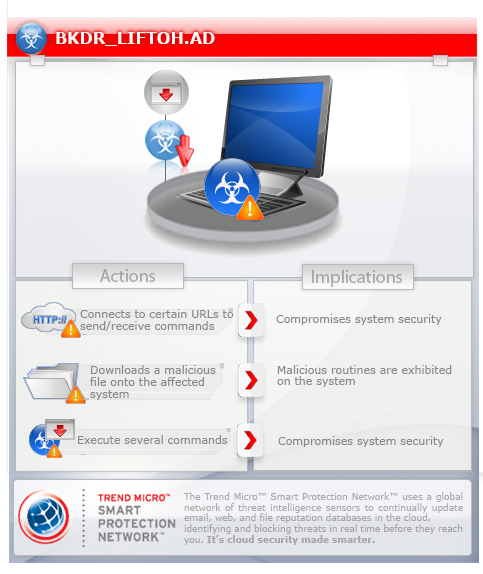BKDR_LIFTOH.AD
Downloader.Liftoh (Symantec); Win32/Injector.AORA (ESET-NOD32)
Windows 2000, Windows Server 2003, Windows XP (32-bit, 64-bit), Windows Vista (32-bit, 64-bit), Windows 7 (32-bit, 64-bit)


Threat Type: Backdoor
Destructiveness: No
Encrypted: Yes
In the wild: Yes
OVERVIEW
Dropped by other malware, Downloaded from the Internet
This malware is involved in a ZBOT spam campaign that targeted British users. Once the malicious attachment is opened, it inevitable leads to the download of ZBOT malware into the affected system.
To get a one-glance comprehensive view of the behavior of this Backdoor, refer to the Threat Diagram shown below.

This backdoor arrives on a system as a file dropped by other malware or as a file downloaded unknowingly by users when visiting malicious sites.
It executes commands from a remote malicious user, effectively compromising the affected system.
TECHNICAL DETAILS
162,816 bytes
EXE
Yes
15 Oct 2013
Connects to URLs/IPs, Downloads files
Arrival Details
This backdoor arrives on a system as a file dropped by other malware or as a file downloaded unknowingly by users when visiting malicious sites.
Installation
This backdoor drops the following copies of itself into the affected system:
- %All Users Profile%\Application Data\{random letters}sacfsfdsf.exe
(Note: %All Users Profile% is the All Users or Common profile folder, which is C:\Documents and Settings\All Users in Windows 2000, XP, and Server 2003, and C:\ProgramData in Windows Vista and 7.)
Autostart Technique
This backdoor adds the following registry entries to enable its automatic execution at every system startup:
HKEY_CURRENT_USER\Software\Microsoft\
Windows\CurrentVersion\Run
{random letters}sacfsfdsf = ""%All Users Profile%\Application Data\{random letters}sacfsfdsf.exe""
Other System Modifications
This backdoor adds the following registry keys:
HKEY_CURRENT_USER\Software\{random letters}sacfsfdsf
It adds the following registry entries as part of its installation routine:
HKEY_CURRENT_USER\Software\{random letters}sacfsfdsf
CurrentPath111 = "%All Users Profile%\Application Data\{random letters}sacfsfdsf.exe"
Backdoor Routine
This backdoor executes the following commands from a remote malicious user:
- Download configuration file
- Update copy of itself
- Download and Execute possibly malicious files
- Inject arbitrary routines to a running process
It connects to the following URL(s) to send and receive commands from a remote malicious user:
- 404.{BLOCKED}dns.com/feed404/feed.php via port 80
NOTES:
As of this writing, this backdoor receives commands from its C&C server to download files from the following URLs:
- feedweb.{BLOCKED}dn.net//feedswebz/html/myupdates.exe
- %All Users Profile%\Application Data\{random file name}.exe - detected as TROJ_AGENT.BGTI
SOLUTION
9.300
10.342.04
15 Oct 2013
10.349.00
16 Oct 2013
Step 1
Before doing any scans, Windows XP, Windows Vista, and Windows 7 users must disable System Restore to allow full scanning of their computers.
Step 3
Restart in Safe Mode
Step 4
Delete this registry key
Important: Editing the Windows Registry incorrectly can lead to irreversible system malfunction. Please do this step only if you know how or you can ask assistance from your system administrator. Else, check this Microsoft article first before modifying your computer's registry.
- In HKEY_CURRENT_USER\Software
- {random letters}sacfsfdsf
- {random letters}sacfsfdsf
Step 5
Delete this registry value
Important: Editing the Windows Registry incorrectly can lead to irreversible system malfunction. Please do this step only if you know how or you can ask assistance from your system administrator. Else, check this Microsoft article first before modifying your computer's registry.
- In HKEY_CURRENT_USER\Software\Microsoft\Windows\CurrentVersion\Run
- {random letters}sacfsfdsf" = ""%All Users Profile%\Application Data\{random letters}sacfsfdsf.exe""
- {random letters}sacfsfdsf" = ""%All Users Profile%\Application Data\{random letters}sacfsfdsf.exe""
Step 6
Restart in normal mode and scan your computer with your Trend Micro product for files detected as BKDR_LIFTOH.AD. If the detected files have already been cleaned, deleted, or quarantined by your Trend Micro product, no further step is required. You may opt to simply delete the quarantined files. Please check this Knowledge Base page for more information.
Did this description help? Tell us how we did.


